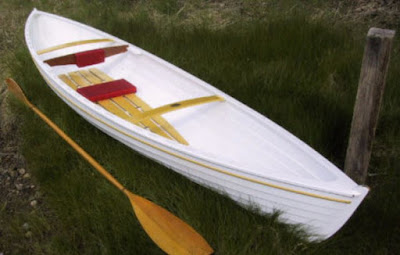In the definition of an ‘oar cruiser’ (see definition under "
About This blog"), the rower is going to sleep in the boat. How do we provide shelter from rain and bugs while sleeping, cooking, eating etc.?
Option 1: Hope it doesn’t rain and bring lots of insect repellant.
Option 2: Use a ‘bivy’ such as the
Uber Bivy
 |
| The Uber Bivy with Rain Hood Folded Back |
This provides rain and bug protection while sleeping and is easily and compactly stored. However, no protection while cooking, eating, etc.
Options 3 & 4: Tents
Following two alternatives are from
PDRacer,com
The first is “The Bottomless Tent”
 |
| The "Bottomless Tent" |
It is a 4’ x 6’ child’s tent with the bottom cut out.
The second is “The Puddle Duck Tube Tent”
 |
| The PDR "Tube Tent" |
The ends are plywood with
clear deck plates available from Duckworks.
I’d mount the deck plates on the inside of the ends and use small patches of window screening on the outside.
The aft end is fastened with shock cord to an available cleat and the forward end is tensioned with a line attached to a second cleat and running through a small hole in the panel to a jam cleat on the inner face.
If the plywood ends were foldable (hinged on vertical seam?), then the whole tent could be more easily stored.
An open-ended variation of the “Tube Tent” could be made from a rectangular section of, for example, Polytarp, with 3 or 4 sleeves that hold fiberglass
tent poles.
Add 6 or 8 ‘sockets’ (see
Duckworks for a wide variety of components that could be used to create this custom shelter) on the decks that would hold the ends of the tent poles. This would provide an open ended tent that would provide rain protection for sleeping, cooking and eating. However, being open ended, no protection from bugs, and if there was wind, not much protection from rain.
Option 5: Bimini Top
 |
| Rick Thompson's Custom Bimini Top |
This is a Bimini top Rick Thompson made for his Walkabout.
A Bimini top could be designed to provide sun protection for the rower and, with multiple sets of deck fittings, could be lowered to cover a (small) cockpit to provide rain protection while sleeping, but no bug protection.
Option 6: Matt Layden’s Sand Flea demonstrates another alternative.
 |
| Matt Layden's Sand Flea |
The sliding hatch covers the cockpit and provides sleeping protection from rain and bugs, but not while cooking/eating, etc.
In an oar cruiser, since the cockpit must be at least 4’ (1.2m) long, two hatches would probably be required, meeting in the middle with an overlap joint.
Ventilation is strongly recommended for any ‘shelter’ solution that is closed, such as this.
My Boat Gear has a good description of various ventilation solutions, some of which are suitable (either purchased or made) for oar cruisers and other small boats.
Option 7: Rick Thompson designed and built a very elegant shelter solution for his Walkabout.
 |
| Rick Thompson's Custom Shelter for His Walkabout |
The two end components fold down to the fore and aft decks. The middle section, used only when full protection is needed, attaches to the other two sections.
Option 8: Dedicated sleeping compartment.
For many, the best solution is a separate ‘sleeping’ compartment as in Colin Angus’s RowCruiser.
 |
| Colin Angus's RowCruiser with Sleeping Cabin |
It is really nice to have a dedicated sleeping compartment such as this. However, there is no protection when cooking, eating, etc.
Option 9: Boom tent.
One of Malcolm Forbes many boats he has owned is a 16’ (4.9m)
Crawford Swampscott Dory in which he currently cruises. These photos show how he has designed
and built a shelter system that enables him to sleep comfortably and yet row
with some protection.
 |
| Malcolm Forbes Swampscott with Shelter Fully Rigged |
 |
| Here, the Shelter has been Rolled Back to Enable Rowing |
 |
| The Four-piece Sleeping Platform |
The shelter is held up by the 'sprit' which is supported by the halyard and a topping lift. The edges are attached to 'hammock hooks' screwed to the bottom of the rub-rail along the shear line.
Option 10: Hoops to support a 3-part tent.
 |
| Using Removable Hoops to Support 'Tent' |
The 'tent' consists of three pieces: A top that snaps to the outside of the hoops and can be rolled up (as shown) when rowing. Two side curtains which snap to the inside of the hoops and are used only for rain protection at night.
Option 11: Two hatches that slide on rails.
Option 12: A custom tent.
This is the custom tent that is included in the plans for the
Pacific Loon.
Also see Paul Butler's article for how to make a
custom tent.




























